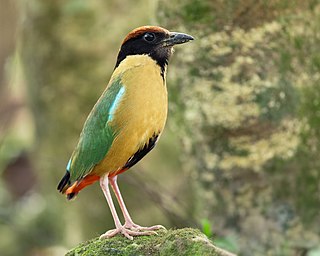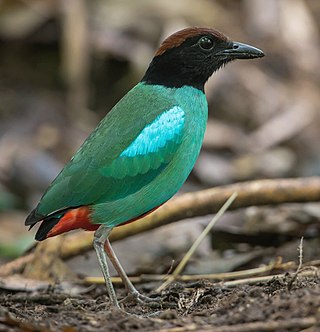
Birds of prey or predatory birds, also known as raptors, are hypercarnivorous bird species that actively hunt and feed on other vertebrates. In addition to speed and strength, these predators have keen eyesight for detecting prey from a distance or during flight, strong feet with sharp talons for grasping or killing prey, and powerful, curved beaks for tearing off flesh. Although predatory birds primarily hunt live prey, many species also scavenge and eat carrion.

The peregrine falcon, also known simply as the peregrine, and historically as the duck hawk in North America, is a cosmopolitan bird of prey (raptor) in the family Falconidae. A large, crow-sized falcon, it has a blue-grey back, barred white underparts, and a black head. The peregrine is renowned for its speed. It can reach over 320 km/h (200 mph) during its characteristic hunting stoop, making it the fastest member of the animal kingdom. According to a National Geographic TV program, the highest measured speed of a peregrine falcon is 389 km/h (242 mph). As is typical for bird-eating (avivore) raptors, peregrine falcons are sexually dimorphic, with females being considerably larger than males.

The merlin is a small species of falcon from the Northern Hemisphere, with numerous subspecies throughout North America and Eurasia. A bird of prey once known colloquially as a pigeon hawk in North America, the merlin breeds in the northern Holarctic; some migrate to subtropical and northern tropical regions in winter. Males typically have wingspans of 53–58 centimetres (21–23 in), with females being slightly larger. They are swift fliers and skilled hunters which specialize in preying on small birds in the size range of sparrows to quail. The merlin has for centuries been well regarded as a falconry bird. In recent decades merlin populations in North America have been significantly increasing, with some merlins becoming so well adapted to city life that they forgo migration.

Kite is the common name for certain birds of prey in the family Accipitridae, particularly in subfamilies Milvinae, Elaninae, and Perninae. The term is derived from Old English cȳta, from the Proto-Indo-European root *gū- , "screech."

The northern wheatear or wheatear is a small passerine bird that was formerly classed as a member of the thrush family Turdidae, but is now more generally considered to be an Old World flycatcher, Muscicapidae. It is the most widespread member of the wheatear genus Oenanthe in Europe and North and Central Asia.

The short-toed snake eagle, also known as the short-toed eagle, is a medium-sized bird of prey in the family Accipitridae, which also includes many other diurnal raptors such as kites, buzzards and harriers. The genus name Circaetus is from the Ancient Greek kirkos, a type of hawk, and aetos, "eagle". The specific gallicus means "of Gallia".

The black-shouldered kite, also known as the Australian black-shouldered kite, is a small raptor found in open habitats throughout Australia. It resembles similar species found in Africa, Eurasia and North America, including the black-winged kite, a species that has in the past also been called "black-shouldered kite". Measuring around 35 cm (14 in) in length, with a wingspan of 80–100 cm (31–39 in), the adult black-shouldered kite has predominantly grey-white plumage and prominent black markings above its red eyes. It gains its name from the black patches on its wings. The primary call is a clear whistle, uttered in flight and while hovering. It can be confused with the related letter-winged kite in Australia, which is distinguished by the striking black markings under its wings.

The American kestrel, also called the sparrow hawk, is the smallest and most common falcon in North America. It has a roughly two-to-one range in size over subspecies and sex, varying in size from about the weight of a blue jay to a mourning dove. It also ranges to South America and is a well-established species that has evolved into 17 subspecies adapted to different environments and habitats throughout the Americas. It exhibits sexual dimorphism in size and plumage, although both sexes have a rufous back with noticeable barring. Its plumage is colorful and attractive, and juveniles are similar in plumage to adults.

The booted eagle is a medium-sized mostly migratory bird of prey with a wide distribution in the Palearctic and southern Asia, wintering in the tropics of Africa and Asia, with a small, disjunct breeding population in south-western Africa. Like all eagles, it belongs to the family Accipitridae.

The red-necked falcon is a bird of prey in the falcon family with two disjunct populations, one in India and the other in Africa. This medium-sized falcon has bluish grey wings and upper body, a chestnut red cap with short chin straps passing through the eye. The primary feathers of the wing are black and a single black band at the tip of the tail are distinctive. The Indian subspecies Falco chicquera chicquera also known as the red-headed merlin or red-headed falcon is found mainly in the open plains of the India Subcontinent although it is thought to have occurred further west in southeastern Iran. The subspecies Falco chicquera ruficollis found in sub-Saharan Africa is sometimes treated as a full species, the rufous-necked falcon, on the basis of its well-separated geographic range and distinctive pattern. It appears very similar to the Indian form but has dark barring on the upperparts, a rufous breast band, and black moustachial and eye stripes. As in most falcons, the females are larger and falconers in India called the female turumti and the male as chatwa. They hunt in pairs mostly at dawn and dusk, capturing small birds, bats and squirrels.

The plumbeous kite is a bird of prey in the family Accipitridae that is resident in much of northern South America. It is migratory in the northern part of its range which extends north to Mexico. It feeds on insects which it catches either from a perch or while in flight.

The swallow-tailed kite is a pernine raptor which breeds from the southeastern United States to eastern Peru and northern Argentina. It is the only species in the genus Elanoides. Most North and Central American breeders winter in South America where the species is resident year round.

The square-tailed kite is a medium-sized bird of prey in the family Accipitridae, which also includes many other diurnal raptors such as kites, eagles and harriers.

Circaetus, the snake eagles, is a genus of medium-sized eagles in the bird of prey family Accipitridae. They are mainly resident African species, but the migratory short-toed snake eagle breeds from the Mediterranean basin into Russia, the Middle East and India, and winters in sub-Saharan Africa and east to Indonesia.

Cracticus is a genus of butcherbirds native to Australasia. They are large songbirds, being between 30 and 40 cm (12–16 in) in length. Their colour ranges from black-and-white to mostly black with added grey plumage, depending on the species. They have a large, straight bill with a distinctive hook at the end which is used to skewer prey. They have high-pitched complex songs, which are used to defend their essentially year-round group territories: unlike birds of extratropical Eurasia and the Americas, both sexes sing prolifically.

The Australian hobby, also known as the little falcon, is one of six Australian members of the family Falconidae. This predominantly diurnal bird of prey derives its name ‘longipennis’ from its long primary wing feathers. It occurs throughout Australia and other neighbouring countries with migrating individuals found on the islands of Indonesia and New Guinea.

Pitta is a genus of birds in the Pittidae, or pitta family. They are secretive, brightly coloured birds that forage on the forest floor. They are long-legged and short-tailed with rounded wings. They all have green on their upperparts with blue wing-patches. Many have dark heads. Nest construction, incubation and rearing of nestlings is performed by both parents. Incubation is completed in some 17 days, and the nestlings are altricial and nidicolous. Some species are migratory.

The rufous hornero is a medium-sized ovenbird in the family Furnariidae. It occurs in eastern South America and is the national bird of Argentina. Also known as the red ovenbird, it is common in savannas, second-growth scrub, pastures, and agricultural land and is synanthropic. Its range includes midwestern, southeastern, and southern Brazil, Bolivia, Paraguay, Uruguay, and northern and central Argentina, extending as far south as northern Patagonia. The species is most closely related to the crested hornero of Paraguay and Argentina. There are four accepted subspecies.

The hooded pitta is a passerine bird in the family Pittidae. It is common in eastern and southeastern Asia and maritime Southeast Asia, where it lives in several types of forests as well as on plantations and other cultivated areas. It is a green bird with a black head and chestnut crown. It forages on the ground for insects and their larvae, and also eats berries. It breeds between February and August, the pair being strongly territorial and building their nest on the ground. Incubation and care of the fledglings is done by both parents. The bird has a wide range, and the International Union for Conservation of Nature has assessed its conservation status as being of "least concern".

Ictinia is a genus of birds in the family Accipitridae. It contains two species that are native to the Americas.


























